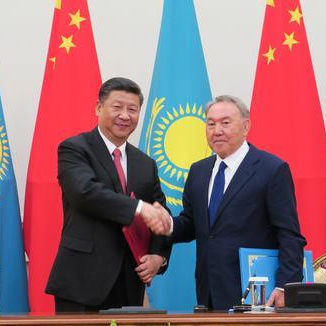The New Silk Road project will offset, to some extent, the circuitous shipping route currently used to send Chinese manufactured goods to lucrative European markets. The current route takes between 30-60 days, the new rail and trucking route, by contrast, will take as few as 10 days. It will, by design, also link every country along the China-Europe corridor. In other words the project “spans more than 65 countries, which together account for 29 per cent of global GDP and 63 per cent of the world’s population.”*

Chinese President Xi Jinping and his Kazakh counterpart, Nursultan Nazarbayev, June 2017 © Getty Image
Resource rich Kazakhstan, who stands to gain substantially by further integration of its economy with that of China, has been particularly eager to embrace this project’s potential. Kazakh officials reaffirm their support as recently as this past week. “The Kazakh government says the two countries have drafted 51 projects worth a total of $27 billion in the energy, mining, infrastructure and other sectors to be carried out by Chinese investors in Kazakhstan between 2016 and 2022.”^
The projected benefits to China are so substantial that Chinese banks have lined up fully behind the initiative. “China’s four major state-owned commercial banks have lent a combined $150 billion up to the end of 2016, over half of all current Belt and Road lending. Beijing has set up several financing vehicles, allocating $50 billion to the Asian Infrastructure Investment Bank, $41 billion to the New Development Bank and $40 billion to the Silk Road Fund.”*
The New Silk Road project further solidifies China as a 21st Century economic super power. Their ability to negotiate a deal involving roughly a third of the countries on the planet also suggests that their diplomatic prowess is becoming more refined and well tuned with every passing year.
References:
*China’s Belt and Road Initiative now up and running by Peter Wong http://www.nationmultimedia.com/detail/Economy/30341970
^Linking China to the EU’s ‘gateway’ for exporters Naubet Bisenov and Stefanie Linhardt https://asia.nikkei.com/Politics-Economy/International-Relations/Linking-China-to-the-EU-s-gateway-for-exporters
China: globalisation’s unlikely champion by Mark Beeson http://theconversation.com/china-globalisations-unlikely-champion-72101


 This is photo was taken at the 2017 Wild Salmon Caravan* – a march to support and increase awareness regarding species protection. Sadly, as I reflect on events like this I find myself pondering things such as… The device which captured this photo likely came as a result of significant environmental damage through it’s manufacturing and pre-purchase transportation. Having said that it is difficult to know whether or not the environmental outcome related to the smartphone would have been better or worse had the manufacturing occurred in a non-communist country. I look forward to gaining insight regarding this question (guess poll below) over the next few months. All for now.
This is photo was taken at the 2017 Wild Salmon Caravan* – a march to support and increase awareness regarding species protection. Sadly, as I reflect on events like this I find myself pondering things such as… The device which captured this photo likely came as a result of significant environmental damage through it’s manufacturing and pre-purchase transportation. Having said that it is difficult to know whether or not the environmental outcome related to the smartphone would have been better or worse had the manufacturing occurred in a non-communist country. I look forward to gaining insight regarding this question (guess poll below) over the next few months. All for now.